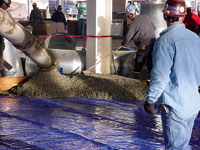 |
| Slimming. At General Motors jobsite in Michigan, lean construction cut rework, time, processing and other costs. (Photo courtesy of General Motors) |
Big construction owners share the plight of their contractors in labor and productivity shortfalls on the jobsite and are pressing colleagues and contractors to find new solutions.
Owner, contractor and labor union officials moved toward that goal at the annual meeting of the Construction Users Roundtable earlier this month in Naples, Fla. Charles Black, president of Tampa Electric Co., a CURT member, noted constructions difficulty in attracting new recruits. "Wages havent kept up with other careers," a situation he says threatens work force stability. Black called for a rise in worker pay. "I am not advocating that owner costs go up. We just need to use wages smartly," he said.
The owners, most representing manufacturing firms, may have been heartened by the number of construction union officials present. But some worry about continuing project impacts linked to the carpenters union decision earlier this year to bolt from the Building and Construction Trades Dept. after leaving the AFL-CIO in 2001 (ENR 8/1 p. 12).
"Our members dont care about the AFL-CIO. They care about jobs," BCTD President Ed Sullivan told attendees Nov. 9. "We still have owners and contractors we made a promise to and we are continuing to uphold that. Im committed to working with other trades even if theyre not in my house."
Carpenters union President Doug McCarron touted his unions push to bolster its training program, noting a $30-million expansion of its Las Vegas training center. "Training is the heart of what we have to offer," he told over 400 attendees.
Union and owner officials revealed details of new labor-management pacts that highlight breakthroughs in jurisdictional disputes. Under pressure from automakers, carpenters and ironworkers union officials signed an agreement Nov. 1 that settles a long dispute between the trades over worker ratios on crews installing and repairing conveyor equipment at auto plants. Crews are typically comprised of ironworkers and millwrights, a carpenters subset.
 "We need to make sure every worker knows how dollars-and-cents decisions are made, and who makes them." "We need to make sure every worker knows how dollars-and-cents decisions are made, and who makes them." Carpenters President Doug McCarron |
 Ironworkers union pact with the carpenters at auto plants "will open doors with them to sit down." Ironworkers union pact with the carpenters at auto plants "will open doors with them to sit down." Ironworkers President Joe Hunt |
The pact applies only to U.S. facilities of "the Big Three," General Motors, Ford Motor Co. and Daimler-Chrysler, and foreign manufacturers. Subcontractors will have to sign "a letter of assent" to have bids accepted at the locations, says the pact. "The carpenters abrogated all agreements with us when they left [the AFL-CIO]," says ironworkers union President Joe Hunt. "This will open doors with them to sit down."
One automaker project official says the dispute never caused work stoppages at plants, but created "background noise" that affected jobsite productivity among both construction and plant employees.
BCTD officials also were set to announce details of a new multi-trade drug enforcement program set to take effect next year as part of CURTs Tri-Partite initiative. But former BCTD Secretary-Treasurer Joe Maloney, who was key in shaping the plan, did not attend the meeting. The approach, approved by CURT last month, would allow union workers to be tested once and certified as drug-free. The certification would last for 12 months and apply to jobsites of all signatory owners, says Steve Satrom, engineering general manager of Air Products & Chemicals Inc. and a Tri-Partitite Commitee leader. Satrom says the program, whose details are still under negotiation, could be in place by next spring.
 |
| Olivier |
One project management approach that CURT intends to embrace is "lean construction," which focuses on high-tech tools and a process to eliminate wasted time and motion that add to cost and schedule excesses.
August Olivier, GMs director of capital projects, explained significant improvements on two company projects (ENR 10/10 p. 28). "Its hard work but we are beginning to see rewards," he said. CURT and the Construction Industry Institute will sponsor new research on the topic and a conference next February.



Post a comment to this article
Report Abusive Comment